Safety and Risk Management in Railway Industry
VerifiedAdded on 2022/12/19
|10
|2060
|221
AI Summary
This paper discusses the importance of safety and risk management in the railway industry, focusing on recent train accidents caused by safety breaches. It also explores the changes in policies and practices implemented after the Richmond train crash.
Contribute Materials
Your contribution can guide someone’s learning journey. Share your
documents today.
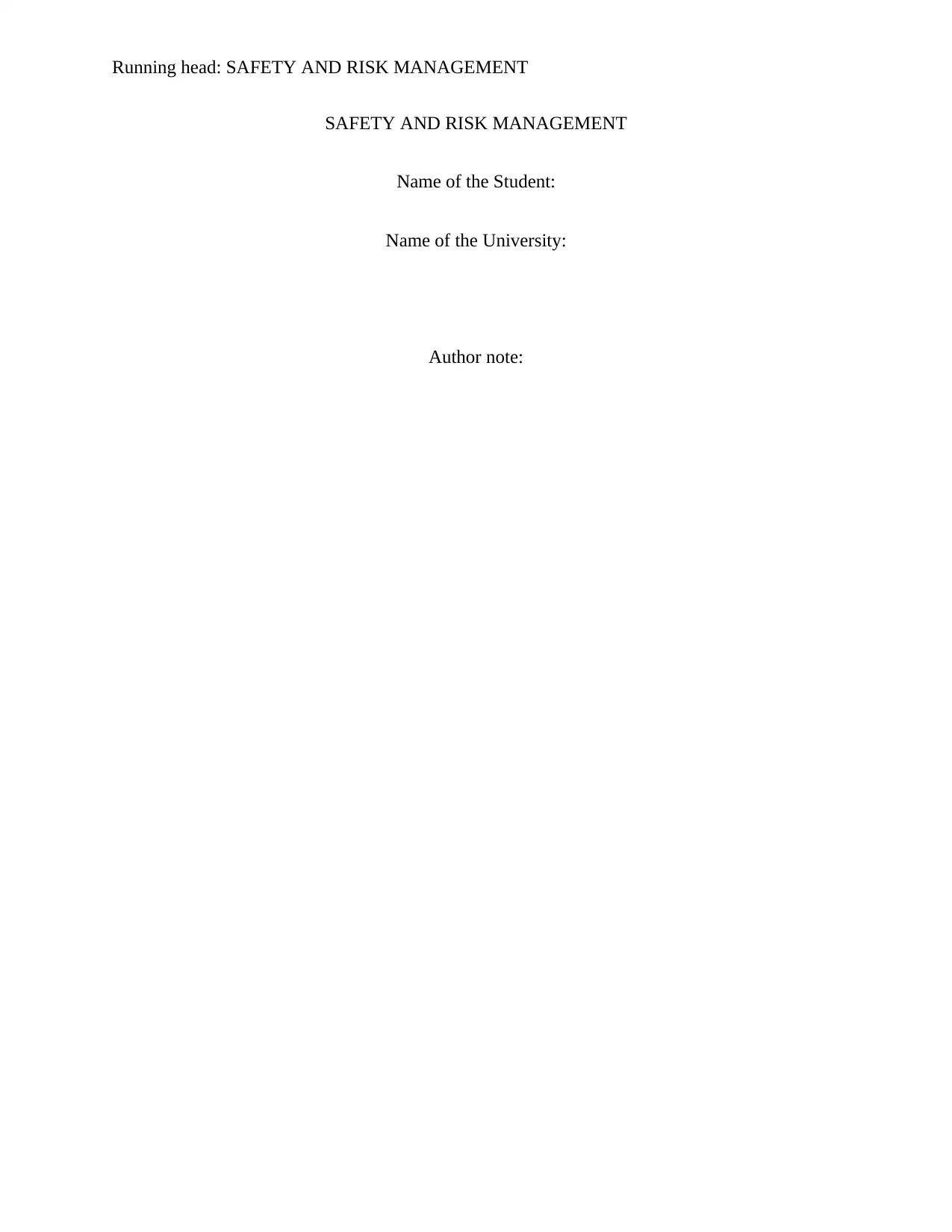
Running head: SAFETY AND RISK MANAGEMENT
SAFETY AND RISK MANAGEMENT
Name of the Student:
Name of the University:
Author note:
SAFETY AND RISK MANAGEMENT
Name of the Student:
Name of the University:
Author note:
Secure Best Marks with AI Grader
Need help grading? Try our AI Grader for instant feedback on your assignments.
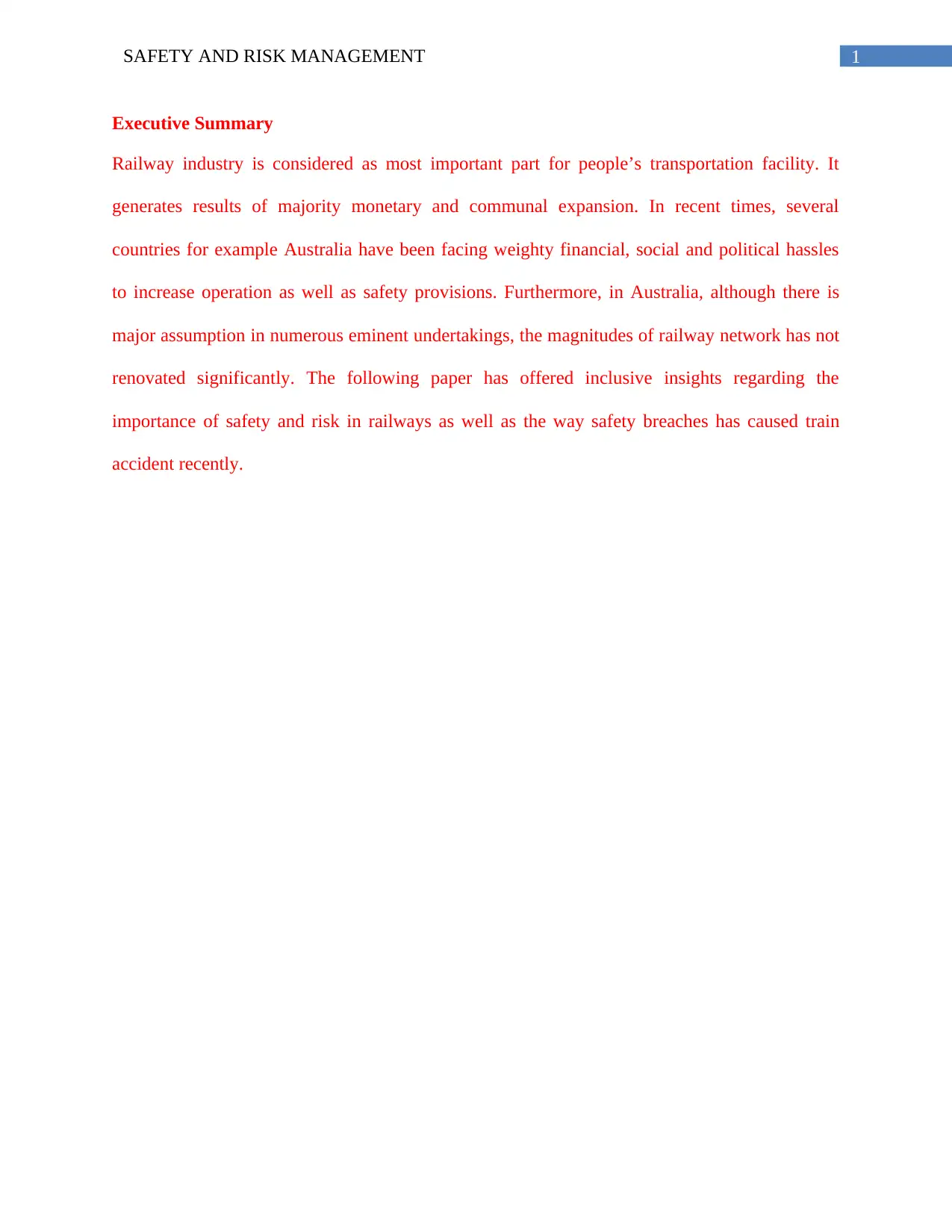
1SAFETY AND RISK MANAGEMENT
Executive Summary
Railway industry is considered as most important part for people’s transportation facility. It
generates results of majority monetary and communal expansion. In recent times, several
countries for example Australia have been facing weighty financial, social and political hassles
to increase operation as well as safety provisions. Furthermore, in Australia, although there is
major assumption in numerous eminent undertakings, the magnitudes of railway network has not
renovated significantly. The following paper has offered inclusive insights regarding the
importance of safety and risk in railways as well as the way safety breaches has caused train
accident recently.
Executive Summary
Railway industry is considered as most important part for people’s transportation facility. It
generates results of majority monetary and communal expansion. In recent times, several
countries for example Australia have been facing weighty financial, social and political hassles
to increase operation as well as safety provisions. Furthermore, in Australia, although there is
major assumption in numerous eminent undertakings, the magnitudes of railway network has not
renovated significantly. The following paper has offered inclusive insights regarding the
importance of safety and risk in railways as well as the way safety breaches has caused train
accident recently.
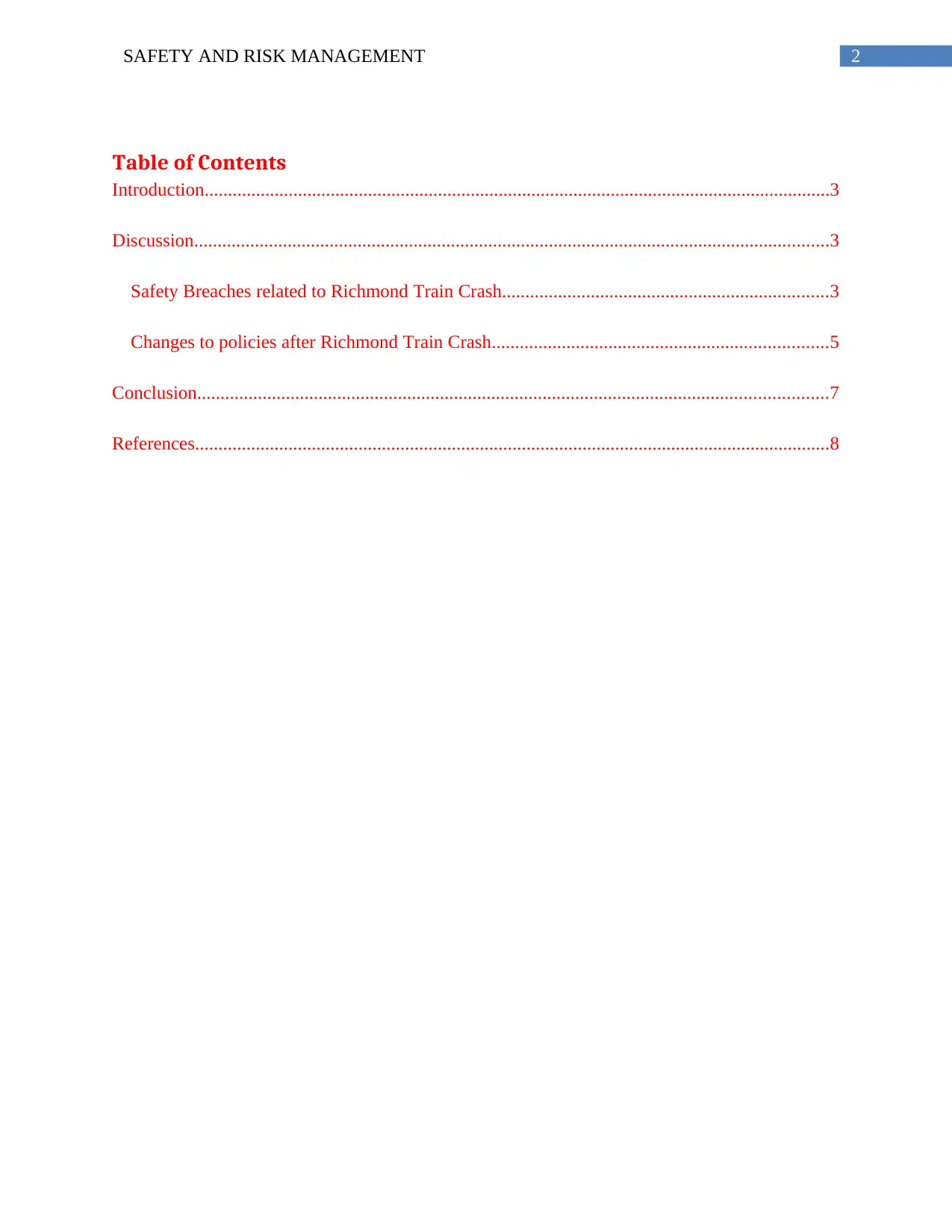
2SAFETY AND RISK MANAGEMENT
Table of Contents
Introduction......................................................................................................................................3
Discussion........................................................................................................................................3
Safety Breaches related to Richmond Train Crash......................................................................3
Changes to policies after Richmond Train Crash........................................................................5
Conclusion.......................................................................................................................................7
References........................................................................................................................................8
Table of Contents
Introduction......................................................................................................................................3
Discussion........................................................................................................................................3
Safety Breaches related to Richmond Train Crash......................................................................3
Changes to policies after Richmond Train Crash........................................................................5
Conclusion.......................................................................................................................................7
References........................................................................................................................................8
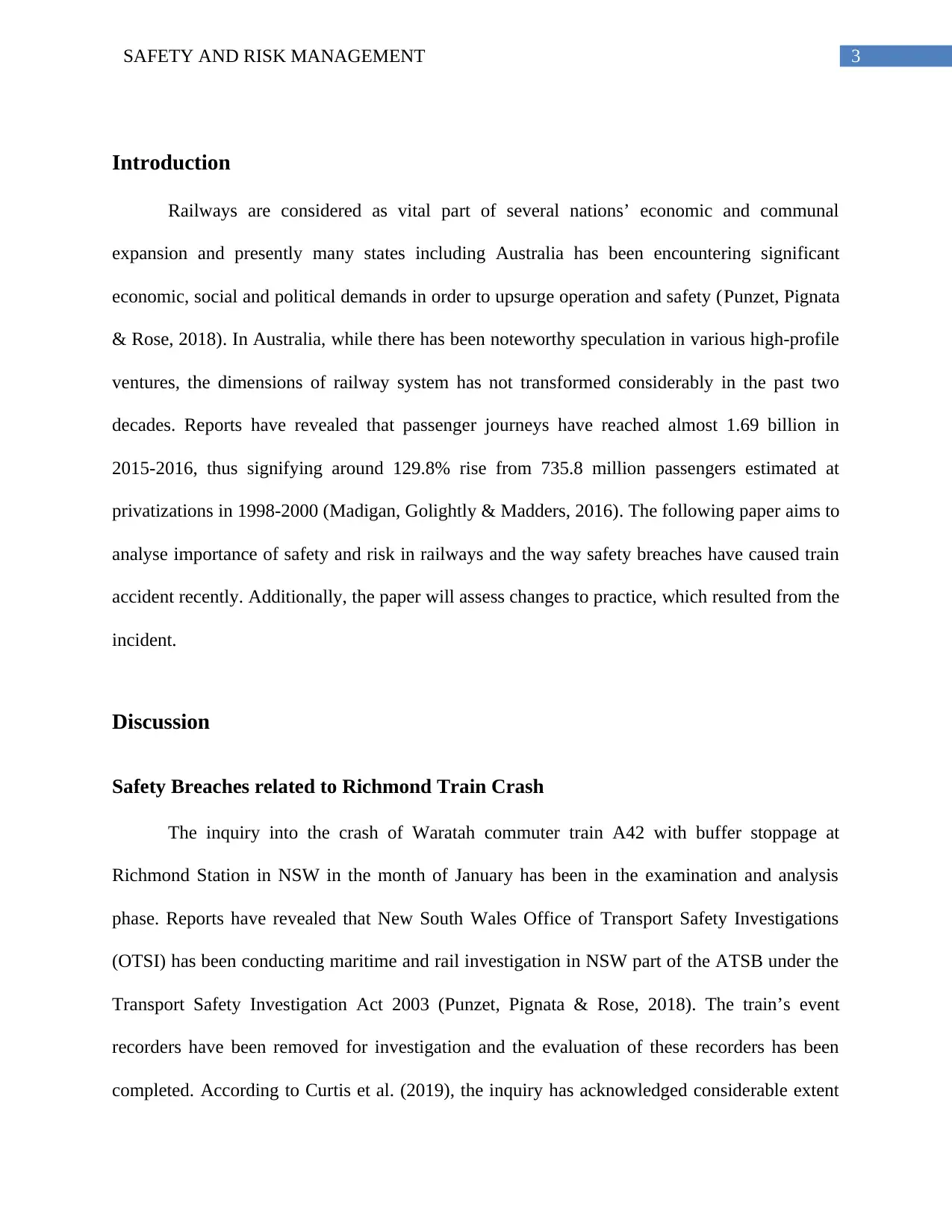
3SAFETY AND RISK MANAGEMENT
Introduction
Railways are considered as vital part of several nations’ economic and communal
expansion and presently many states including Australia has been encountering significant
economic, social and political demands in order to upsurge operation and safety (Punzet, Pignata
& Rose, 2018). In Australia, while there has been noteworthy speculation in various high-profile
ventures, the dimensions of railway system has not transformed considerably in the past two
decades. Reports have revealed that passenger journeys have reached almost 1.69 billion in
2015-2016, thus signifying around 129.8% rise from 735.8 million passengers estimated at
privatizations in 1998-2000 (Madigan, Golightly & Madders, 2016). The following paper aims to
analyse importance of safety and risk in railways and the way safety breaches have caused train
accident recently. Additionally, the paper will assess changes to practice, which resulted from the
incident.
Discussion
Safety Breaches related to Richmond Train Crash
The inquiry into the crash of Waratah commuter train A42 with buffer stoppage at
Richmond Station in NSW in the month of January has been in the examination and analysis
phase. Reports have revealed that New South Wales Office of Transport Safety Investigations
(OTSI) has been conducting maritime and rail investigation in NSW part of the ATSB under the
Transport Safety Investigation Act 2003 (Punzet, Pignata & Rose, 2018). The train’s event
recorders have been removed for investigation and the evaluation of these recorders has been
completed. According to Curtis et al. (2019), the inquiry has acknowledged considerable extent
Introduction
Railways are considered as vital part of several nations’ economic and communal
expansion and presently many states including Australia has been encountering significant
economic, social and political demands in order to upsurge operation and safety (Punzet, Pignata
& Rose, 2018). In Australia, while there has been noteworthy speculation in various high-profile
ventures, the dimensions of railway system has not transformed considerably in the past two
decades. Reports have revealed that passenger journeys have reached almost 1.69 billion in
2015-2016, thus signifying around 129.8% rise from 735.8 million passengers estimated at
privatizations in 1998-2000 (Madigan, Golightly & Madders, 2016). The following paper aims to
analyse importance of safety and risk in railways and the way safety breaches have caused train
accident recently. Additionally, the paper will assess changes to practice, which resulted from the
incident.
Discussion
Safety Breaches related to Richmond Train Crash
The inquiry into the crash of Waratah commuter train A42 with buffer stoppage at
Richmond Station in NSW in the month of January has been in the examination and analysis
phase. Reports have revealed that New South Wales Office of Transport Safety Investigations
(OTSI) has been conducting maritime and rail investigation in NSW part of the ATSB under the
Transport Safety Investigation Act 2003 (Punzet, Pignata & Rose, 2018). The train’s event
recorders have been removed for investigation and the evaluation of these recorders has been
completed. According to Curtis et al. (2019), the inquiry has acknowledged considerable extent
Secure Best Marks with AI Grader
Need help grading? Try our AI Grader for instant feedback on your assignments.
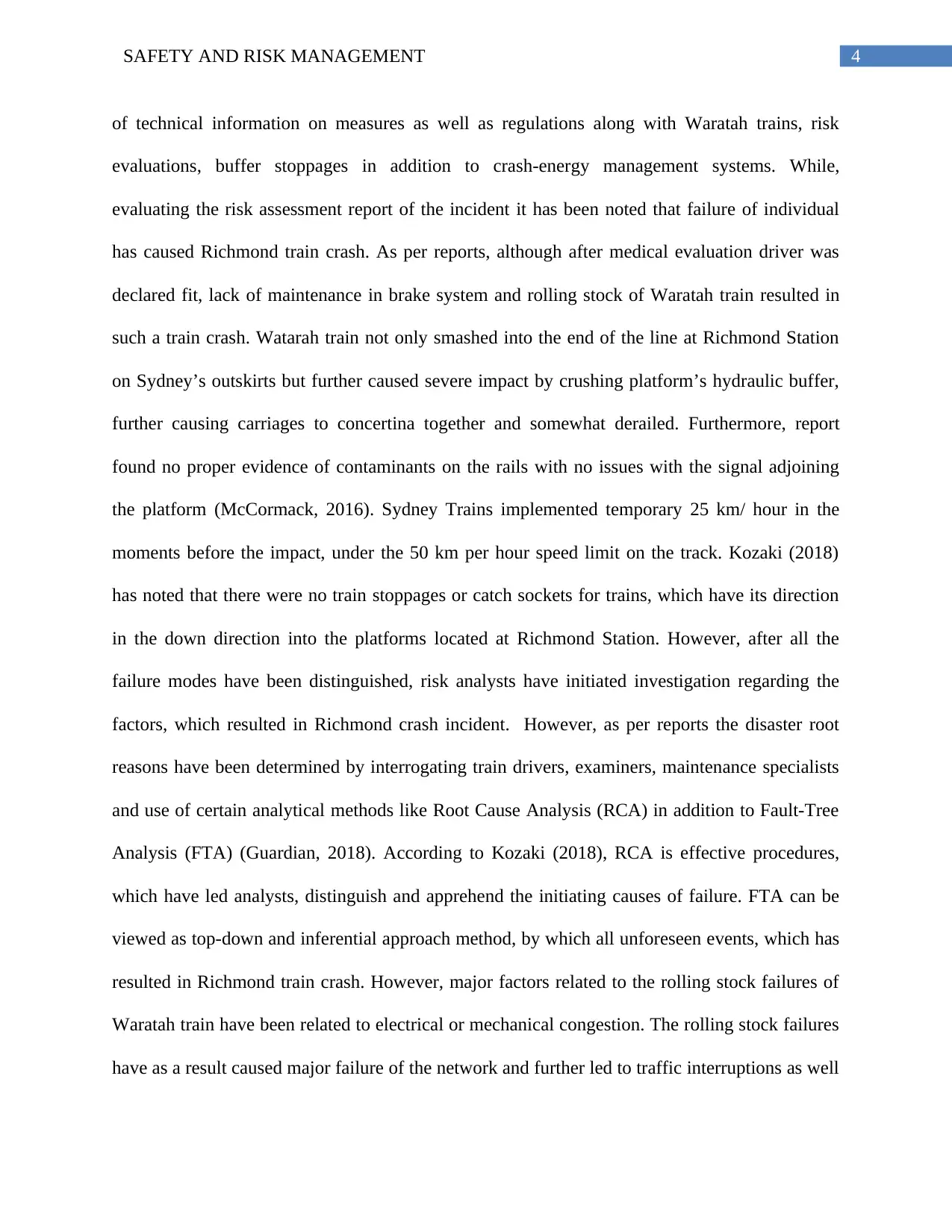
4SAFETY AND RISK MANAGEMENT
of technical information on measures as well as regulations along with Waratah trains, risk
evaluations, buffer stoppages in addition to crash-energy management systems. While,
evaluating the risk assessment report of the incident it has been noted that failure of individual
has caused Richmond train crash. As per reports, although after medical evaluation driver was
declared fit, lack of maintenance in brake system and rolling stock of Waratah train resulted in
such a train crash. Watarah train not only smashed into the end of the line at Richmond Station
on Sydney’s outskirts but further caused severe impact by crushing platform’s hydraulic buffer,
further causing carriages to concertina together and somewhat derailed. Furthermore, report
found no proper evidence of contaminants on the rails with no issues with the signal adjoining
the platform (McCormack, 2016). Sydney Trains implemented temporary 25 km/ hour in the
moments before the impact, under the 50 km per hour speed limit on the track. Kozaki (2018)
has noted that there were no train stoppages or catch sockets for trains, which have its direction
in the down direction into the platforms located at Richmond Station. However, after all the
failure modes have been distinguished, risk analysts have initiated investigation regarding the
factors, which resulted in Richmond crash incident. However, as per reports the disaster root
reasons have been determined by interrogating train drivers, examiners, maintenance specialists
and use of certain analytical methods like Root Cause Analysis (RCA) in addition to Fault-Tree
Analysis (FTA) (Guardian, 2018). According to Kozaki (2018), RCA is effective procedures,
which have led analysts, distinguish and apprehend the initiating causes of failure. FTA can be
viewed as top-down and inferential approach method, by which all unforeseen events, which has
resulted in Richmond train crash. However, major factors related to the rolling stock failures of
Waratah train have been related to electrical or mechanical congestion. The rolling stock failures
have as a result caused major failure of the network and further led to traffic interruptions as well
of technical information on measures as well as regulations along with Waratah trains, risk
evaluations, buffer stoppages in addition to crash-energy management systems. While,
evaluating the risk assessment report of the incident it has been noted that failure of individual
has caused Richmond train crash. As per reports, although after medical evaluation driver was
declared fit, lack of maintenance in brake system and rolling stock of Waratah train resulted in
such a train crash. Watarah train not only smashed into the end of the line at Richmond Station
on Sydney’s outskirts but further caused severe impact by crushing platform’s hydraulic buffer,
further causing carriages to concertina together and somewhat derailed. Furthermore, report
found no proper evidence of contaminants on the rails with no issues with the signal adjoining
the platform (McCormack, 2016). Sydney Trains implemented temporary 25 km/ hour in the
moments before the impact, under the 50 km per hour speed limit on the track. Kozaki (2018)
has noted that there were no train stoppages or catch sockets for trains, which have its direction
in the down direction into the platforms located at Richmond Station. However, after all the
failure modes have been distinguished, risk analysts have initiated investigation regarding the
factors, which resulted in Richmond crash incident. However, as per reports the disaster root
reasons have been determined by interrogating train drivers, examiners, maintenance specialists
and use of certain analytical methods like Root Cause Analysis (RCA) in addition to Fault-Tree
Analysis (FTA) (Guardian, 2018). According to Kozaki (2018), RCA is effective procedures,
which have led analysts, distinguish and apprehend the initiating causes of failure. FTA can be
viewed as top-down and inferential approach method, by which all unforeseen events, which has
resulted in Richmond train crash. However, major factors related to the rolling stock failures of
Waratah train have been related to electrical or mechanical congestion. The rolling stock failures
have as a result caused major failure of the network and further led to traffic interruptions as well
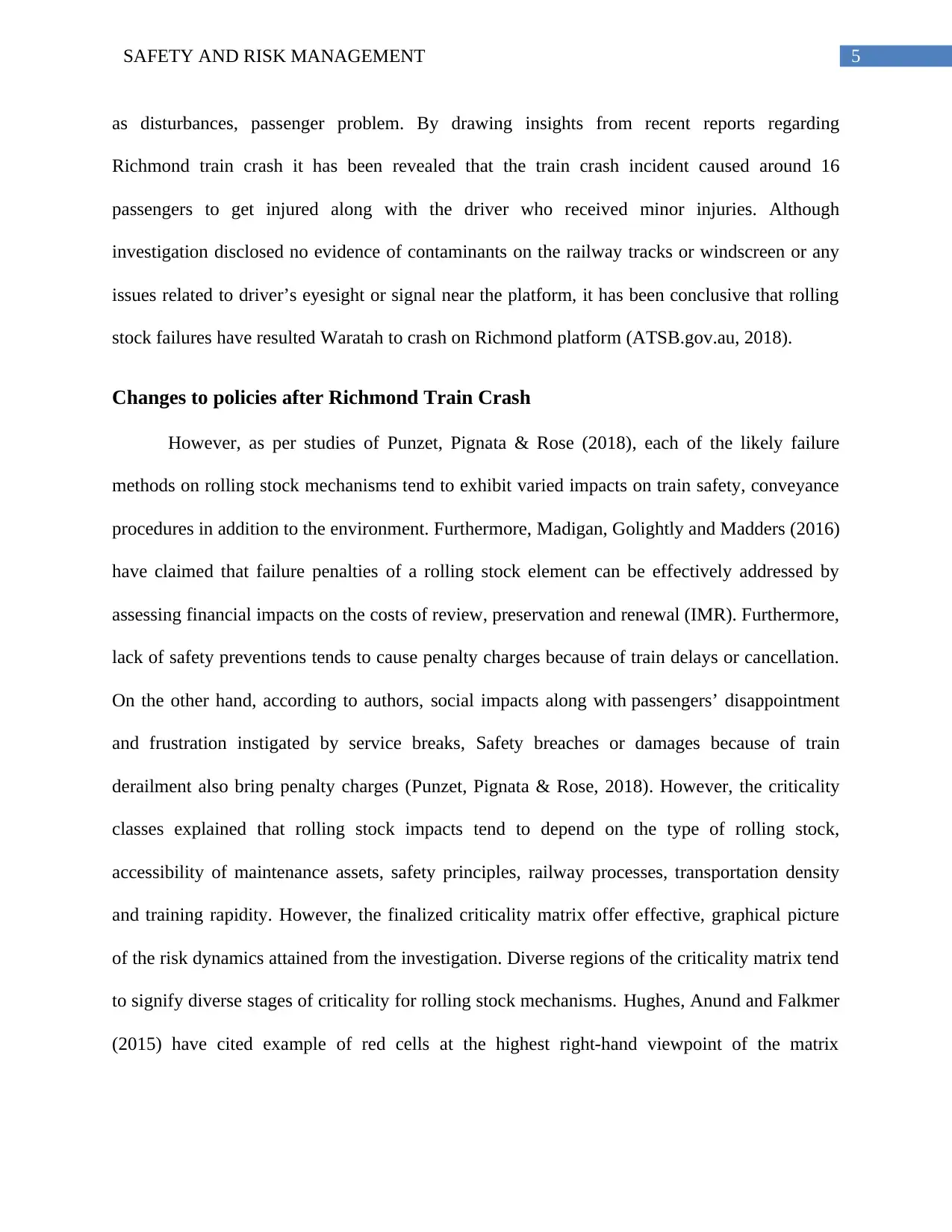
5SAFETY AND RISK MANAGEMENT
as disturbances, passenger problem. By drawing insights from recent reports regarding
Richmond train crash it has been revealed that the train crash incident caused around 16
passengers to get injured along with the driver who received minor injuries. Although
investigation disclosed no evidence of contaminants on the railway tracks or windscreen or any
issues related to driver’s eyesight or signal near the platform, it has been conclusive that rolling
stock failures have resulted Waratah to crash on Richmond platform (ATSB.gov.au, 2018).
Changes to policies after Richmond Train Crash
However, as per studies of Punzet, Pignata & Rose (2018), each of the likely failure
methods on rolling stock mechanisms tend to exhibit varied impacts on train safety, conveyance
procedures in addition to the environment. Furthermore, Madigan, Golightly and Madders (2016)
have claimed that failure penalties of a rolling stock element can be effectively addressed by
assessing financial impacts on the costs of review, preservation and renewal (IMR). Furthermore,
lack of safety preventions tends to cause penalty charges because of train delays or cancellation.
On the other hand, according to authors, social impacts along with passengers’ disappointment
and frustration instigated by service breaks, Safety breaches or damages because of train
derailment also bring penalty charges (Punzet, Pignata & Rose, 2018). However, the criticality
classes explained that rolling stock impacts tend to depend on the type of rolling stock,
accessibility of maintenance assets, safety principles, railway processes, transportation density
and training rapidity. However, the finalized criticality matrix offer effective, graphical picture
of the risk dynamics attained from the investigation. Diverse regions of the criticality matrix tend
to signify diverse stages of criticality for rolling stock mechanisms. Hughes, Anund and Falkmer
(2015) have cited example of red cells at the highest right-hand viewpoint of the matrix
as disturbances, passenger problem. By drawing insights from recent reports regarding
Richmond train crash it has been revealed that the train crash incident caused around 16
passengers to get injured along with the driver who received minor injuries. Although
investigation disclosed no evidence of contaminants on the railway tracks or windscreen or any
issues related to driver’s eyesight or signal near the platform, it has been conclusive that rolling
stock failures have resulted Waratah to crash on Richmond platform (ATSB.gov.au, 2018).
Changes to policies after Richmond Train Crash
However, as per studies of Punzet, Pignata & Rose (2018), each of the likely failure
methods on rolling stock mechanisms tend to exhibit varied impacts on train safety, conveyance
procedures in addition to the environment. Furthermore, Madigan, Golightly and Madders (2016)
have claimed that failure penalties of a rolling stock element can be effectively addressed by
assessing financial impacts on the costs of review, preservation and renewal (IMR). Furthermore,
lack of safety preventions tends to cause penalty charges because of train delays or cancellation.
On the other hand, according to authors, social impacts along with passengers’ disappointment
and frustration instigated by service breaks, Safety breaches or damages because of train
derailment also bring penalty charges (Punzet, Pignata & Rose, 2018). However, the criticality
classes explained that rolling stock impacts tend to depend on the type of rolling stock,
accessibility of maintenance assets, safety principles, railway processes, transportation density
and training rapidity. However, the finalized criticality matrix offer effective, graphical picture
of the risk dynamics attained from the investigation. Diverse regions of the criticality matrix tend
to signify diverse stages of criticality for rolling stock mechanisms. Hughes, Anund and Falkmer
(2015) have cited example of red cells at the highest right-hand viewpoint of the matrix

6SAFETY AND RISK MANAGEMENT
exemplifying ‘‘very high critical’’ area, although the green cells at the lowest left-hand position
characterize ‘‘very low critical’’ province.
However, in order to obtain an adequate level of criticality as well as improve the
dependability of the network, certain development movements require be proposing or initiating
for medium, high in addition to extensively critical failure approaches as well as mechanisms.
Meanwhile, the Australian railway industry has offered different interfaces after the Richmond
incident from a number of organisations with whom Rail Safety and Standards Board closely
associates (Crawford & Kift, 2018). Moreover, Australian railway board in its pursuit of
mitigating any further safety breaches and further aid railway sector to progress especially in
regards to innovation, information, principles and most importantly safety. Furthermore, railway
board of Australia has strongly promoted the critical prominence of understanding risk,
investigation and analysis. Authors have noted that Australian Railway board has aimed to
promote Safety Management Information System (SMIS) that has been recognized as
significantly large database designed for all the train-operating businesses, setup in addition to
railway functions. However, all these are required by Railway Group Standards in order to
import all safety-related incidents as well as accidents into the SMIS (Filtness & Naweed, 2017).
In case of further train crashes, Australian railway risk-control systems or aspects, which
add to the train crash, can include the driver’s training, improving knowledge development of
drivers regrading directions, and most importantly preventing risks and improving safety
breaches for train for automatic protection. However, when all these issues tend to emerge, they
might result in severe safety breaches and train crashes related to failure of rolling stock in
addition to those fatalities (Kozaki, 2018). However, these severe breaches could be easily
exemplifying ‘‘very high critical’’ area, although the green cells at the lowest left-hand position
characterize ‘‘very low critical’’ province.
However, in order to obtain an adequate level of criticality as well as improve the
dependability of the network, certain development movements require be proposing or initiating
for medium, high in addition to extensively critical failure approaches as well as mechanisms.
Meanwhile, the Australian railway industry has offered different interfaces after the Richmond
incident from a number of organisations with whom Rail Safety and Standards Board closely
associates (Crawford & Kift, 2018). Moreover, Australian railway board in its pursuit of
mitigating any further safety breaches and further aid railway sector to progress especially in
regards to innovation, information, principles and most importantly safety. Furthermore, railway
board of Australia has strongly promoted the critical prominence of understanding risk,
investigation and analysis. Authors have noted that Australian Railway board has aimed to
promote Safety Management Information System (SMIS) that has been recognized as
significantly large database designed for all the train-operating businesses, setup in addition to
railway functions. However, all these are required by Railway Group Standards in order to
import all safety-related incidents as well as accidents into the SMIS (Filtness & Naweed, 2017).
In case of further train crashes, Australian railway risk-control systems or aspects, which
add to the train crash, can include the driver’s training, improving knowledge development of
drivers regrading directions, and most importantly preventing risks and improving safety
breaches for train for automatic protection. However, when all these issues tend to emerge, they
might result in severe safety breaches and train crashes related to failure of rolling stock in
addition to those fatalities (Kozaki, 2018). However, these severe breaches could be easily
Paraphrase This Document
Need a fresh take? Get an instant paraphrase of this document with our AI Paraphraser
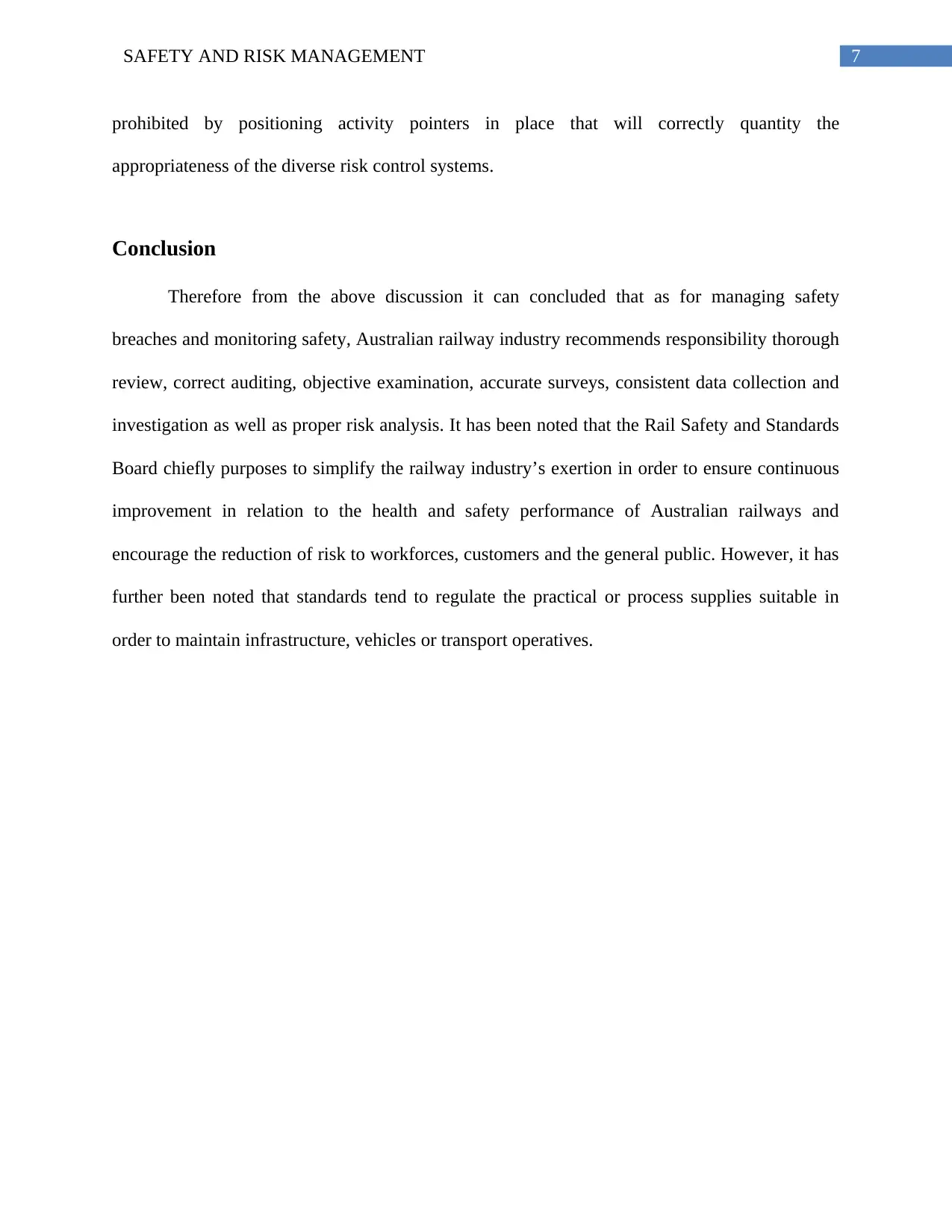
7SAFETY AND RISK MANAGEMENT
prohibited by positioning activity pointers in place that will correctly quantity the
appropriateness of the diverse risk control systems.
Conclusion
Therefore from the above discussion it can concluded that as for managing safety
breaches and monitoring safety, Australian railway industry recommends responsibility thorough
review, correct auditing, objective examination, accurate surveys, consistent data collection and
investigation as well as proper risk analysis. It has been noted that the Rail Safety and Standards
Board chiefly purposes to simplify the railway industry’s exertion in order to ensure continuous
improvement in relation to the health and safety performance of Australian railways and
encourage the reduction of risk to workforces, customers and the general public. However, it has
further been noted that standards tend to regulate the practical or process supplies suitable in
order to maintain infrastructure, vehicles or transport operatives.
prohibited by positioning activity pointers in place that will correctly quantity the
appropriateness of the diverse risk control systems.
Conclusion
Therefore from the above discussion it can concluded that as for managing safety
breaches and monitoring safety, Australian railway industry recommends responsibility thorough
review, correct auditing, objective examination, accurate surveys, consistent data collection and
investigation as well as proper risk analysis. It has been noted that the Rail Safety and Standards
Board chiefly purposes to simplify the railway industry’s exertion in order to ensure continuous
improvement in relation to the health and safety performance of Australian railways and
encourage the reduction of risk to workforces, customers and the general public. However, it has
further been noted that standards tend to regulate the practical or process supplies suitable in
order to maintain infrastructure, vehicles or transport operatives.
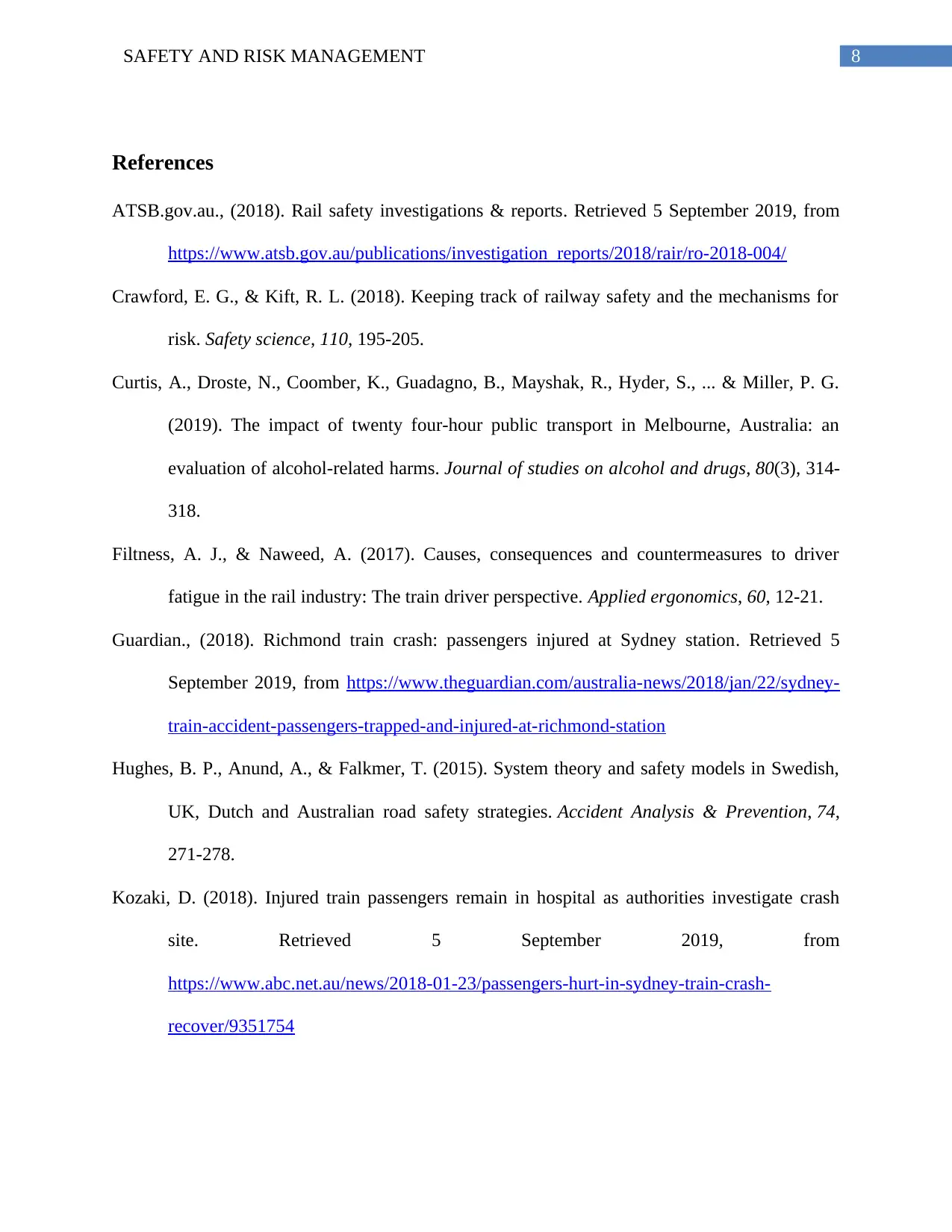
8SAFETY AND RISK MANAGEMENT
References
ATSB.gov.au., (2018). Rail safety investigations & reports. Retrieved 5 September 2019, from
https://www.atsb.gov.au/publications/investigation_reports/2018/rair/ro-2018-004/
Crawford, E. G., & Kift, R. L. (2018). Keeping track of railway safety and the mechanisms for
risk. Safety science, 110, 195-205.
Curtis, A., Droste, N., Coomber, K., Guadagno, B., Mayshak, R., Hyder, S., ... & Miller, P. G.
(2019). The impact of twenty four-hour public transport in Melbourne, Australia: an
evaluation of alcohol-related harms. Journal of studies on alcohol and drugs, 80(3), 314-
318.
Filtness, A. J., & Naweed, A. (2017). Causes, consequences and countermeasures to driver
fatigue in the rail industry: The train driver perspective. Applied ergonomics, 60, 12-21.
Guardian., (2018). Richmond train crash: passengers injured at Sydney station. Retrieved 5
September 2019, from https://www.theguardian.com/australia-news/2018/jan/22/sydney-
train-accident-passengers-trapped-and-injured-at-richmond-station
Hughes, B. P., Anund, A., & Falkmer, T. (2015). System theory and safety models in Swedish,
UK, Dutch and Australian road safety strategies. Accident Analysis & Prevention, 74,
271-278.
Kozaki, D. (2018). Injured train passengers remain in hospital as authorities investigate crash
site. Retrieved 5 September 2019, from
https://www.abc.net.au/news/2018-01-23/passengers-hurt-in-sydney-train-crash-
recover/9351754
References
ATSB.gov.au., (2018). Rail safety investigations & reports. Retrieved 5 September 2019, from
https://www.atsb.gov.au/publications/investigation_reports/2018/rair/ro-2018-004/
Crawford, E. G., & Kift, R. L. (2018). Keeping track of railway safety and the mechanisms for
risk. Safety science, 110, 195-205.
Curtis, A., Droste, N., Coomber, K., Guadagno, B., Mayshak, R., Hyder, S., ... & Miller, P. G.
(2019). The impact of twenty four-hour public transport in Melbourne, Australia: an
evaluation of alcohol-related harms. Journal of studies on alcohol and drugs, 80(3), 314-
318.
Filtness, A. J., & Naweed, A. (2017). Causes, consequences and countermeasures to driver
fatigue in the rail industry: The train driver perspective. Applied ergonomics, 60, 12-21.
Guardian., (2018). Richmond train crash: passengers injured at Sydney station. Retrieved 5
September 2019, from https://www.theguardian.com/australia-news/2018/jan/22/sydney-
train-accident-passengers-trapped-and-injured-at-richmond-station
Hughes, B. P., Anund, A., & Falkmer, T. (2015). System theory and safety models in Swedish,
UK, Dutch and Australian road safety strategies. Accident Analysis & Prevention, 74,
271-278.
Kozaki, D. (2018). Injured train passengers remain in hospital as authorities investigate crash
site. Retrieved 5 September 2019, from
https://www.abc.net.au/news/2018-01-23/passengers-hurt-in-sydney-train-crash-
recover/9351754

9SAFETY AND RISK MANAGEMENT
Madigan, R., Golightly, D., & Madders, R. (2016). Application of Human Factors Analysis and
Classification System (HFACS) to UK rail safety of the line incidents. Accident Analysis
& Prevention, 97, 122-131.
McCormack, K. (2016). London Local Trains in the 1950s and 1960s. Pen and Sword.
Punzet, L., Pignata, S., & Rose, J. (2018). Error types and potential mitigation strategies in
Signal Passed at Danger (SPAD) events in an Australian rail organisation. Safety
science, 110, 89-99.
Madigan, R., Golightly, D., & Madders, R. (2016). Application of Human Factors Analysis and
Classification System (HFACS) to UK rail safety of the line incidents. Accident Analysis
& Prevention, 97, 122-131.
McCormack, K. (2016). London Local Trains in the 1950s and 1960s. Pen and Sword.
Punzet, L., Pignata, S., & Rose, J. (2018). Error types and potential mitigation strategies in
Signal Passed at Danger (SPAD) events in an Australian rail organisation. Safety
science, 110, 89-99.
1 out of 10
Related Documents
Your All-in-One AI-Powered Toolkit for Academic Success.
+13062052269
info@desklib.com
Available 24*7 on WhatsApp / Email
![[object Object]](/_next/static/media/star-bottom.7253800d.svg)
Unlock your academic potential
© 2024 | Zucol Services PVT LTD | All rights reserved.





